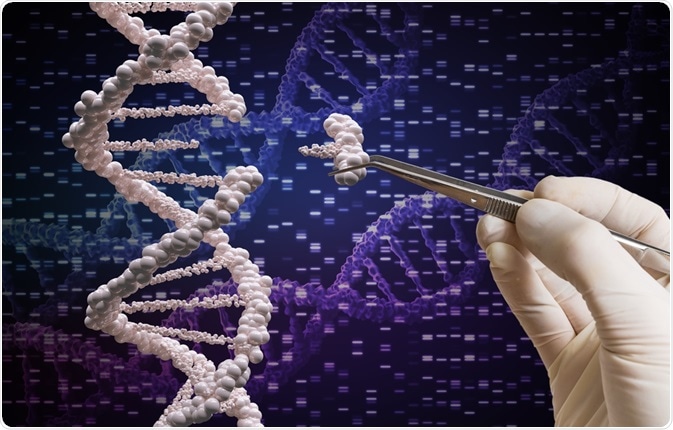Clustered regularly interspaced short palindromic repeat (CRISPR) technology has quickly become a staple research method in the life sciences, allowing the genome of living organisms to be modified and thereby allowing the function of genes to be uncovered, highly specific animal and cell line models to be prepared, and new gene-editing based therapies to be developed, among an extensive list of additional applications.

DNA. Image Credit: ESB Professional/Shutterstock.com
The clustered repeating DNA sequences that would later be known as CRISPR were first identified in the late 1980s and early 1990s, though the function had yet to be discovered. Evidence that the CRISPR regions were transcribed into long RNA sequences and subsequently processed into small RNAs came in the early 2000s, and an association with increased phage resistance in bacteria that bore additional CRISPR sequences was later noted.
CRISPR-associated cas genes were later recognized, which when transcribed into Cas proteins locate and cleave target DNA in a highly specific manner guided by the CRISPR-generated RNA. By replacing this endogenously derived RNA with synthetic RNA specific sections of the genome can be targeted, work for which Emmanuelle Charpentier and Jennifer Doudna were awarded the Nobel prize in chemistry in 2020.
Within the last decade, numerous subtypes of the CRISPR-Cas system have been developed for particular applications, allowing gene editing to take place in ever greater detail, with greater specificity. For example, having established the ability of the CRISPR-Cas9 system to introduce edits to the genome, the ability to induce single point mutations remained elusive as the Cas protein cleaves double-stranded DNA.
Many diseases such as cancer are often caused by such single-point mutations to the genome, and thus the ability to locate and repair such an error would be of great benefit therapeutically. CRISPR base editors have been developed that, instead of cleaving dsDNA and allowing the break to be repaired by cellular machinery, generate an R-loop structure that exposes ssDNA, allowing a single base to be excised and replaced.
This type of mechanism has been achieved by the creation of fusion proteins, those generated by the synthetic combining of two or more genes resulting in a novel protein with an intentionally engineered function.
Nucleic acid imaging
CRISPR systems have been developed for real-time imaging of the genome, inserting fluorescently tagged RNAs into the sequence at the loci of interest. Currently, the technology requires around 26 or more fluorescently tagged RNA strands to be active to obtain a detectable signal, and the method is intended to be applied to non-repetitive protein-coding genes.
Fluorophores of varied wavelengths can be employed to simultaneously track multiple features, and the method can also be applied to study RNA system dynamics within cells. In this case, the Cas9 protein must be modified to bear a synthetic oligo protospacer to target RNA, while Cas13 innately targets mRNAs. The architecture of the chromosomes and transcriptional dynamics of the cell under various conditions have been better understood in recent years thanks to CRISPR.

CRISPR. Image Credit: vchal/Shutterstock.com
CRISPR in plant breeding
Hybrid offspring frequently exhibit beneficial traits in a phenomenon known as heterosis, which the agricultural industry exploits strongly to produce fast-growing high-yield crops. However, the need to continuously breed each generation with a lineage that is distinct enough to avoid inbreeding, while being genetically “superior”, if the subsequent generation is to be an improvement on the last, has led to a severe bottlenecking in further refinement.
CRISPR has been employed to edit four genes involved in meiosis and fertilization in rice, allowing clonal asexual propagation, eliminating issues associated with inbreeding and loss of favorable phenotypes. Similar CRISPR-Cas9 genome editing has taken place in tomato plants, modifying three genes involved in stem length, flowering rate, and growth termination stage, producing more compact and faster-producing plants suitable for urban agriculture.
CRISPR in animal models
Gene-edited animal models are usually produced at the zygote stage, with the gene modification system microinjected into the cell. Larger animals in particular benefit from CRISPR-based methods, and they can be injected into the zygote and the resultant embryo transferred later. Numerous disease-specific animal models have been developed in this way, such as Huntington's disease pigs.
Nanoparticle carrier systems have been utilized to deliver CRISPR platforms directly to target organs in living adult animals, and a very recently emerging platform known as prime editing can delete and insert genes without creating double-strand breaks in the DNA of living organisms. Prime editing uses a Cas9 fusion protein, having been modified to be unable to fully cleave dsDNA, combined with a reverse transcriptase enzyme that generates complementary DNA from an RNA guide template.
Since this system utilizes DNA mismatch repair rather than homology-directed repair to fix the DNA break there are generally fewer random mistaken deletions or insertions, and prime editing is associated with fewer off-target effects thanks to the three stages of DNA binding required: between the guide RNA sequence and target DNA, the primer and the DNA, and then finally the now nicked DNA strand with the inserted RNA.
Ultimately it is hoped that CRISPR platforms will enable safe correction of aberrant genomes, allowing a wide range of diseases to be treated on the genetic level. Clinical trials are underway for the treatment of cancers, HIV, and sickle cell anemia, among others, though with mixed results. Worries regarding editing the human genome have been raised, however, both from an ethical and safety perspective, and the push for clinical trials is slowed by caution.
Sources:
- Uddin, F., Rudin, C. M. & Sen, T. (2020) CRISPR Gene Therapy: Applications, Limitations, and Implications for the Future. Frontiers in Oncology, 10 https://www.frontiersin.org/articles/10.3389/fonc.2020.01387/full
- Chen, B. et al. (2020) Recent advances in CRISPR research. Protein & Cell, 11 link.springer.com/.../s13238-020-00704-y
- Pal, M. & Herold, M. J. (2021) CRISPR base editing applications for identifying cancer-driving mutations. Biochemical Society Transactions, 49(1) portlandpress.com/.../CRISPR-base-editing-applications-for-identifying
Further Reading
Last Updated: Jan 17, 2022